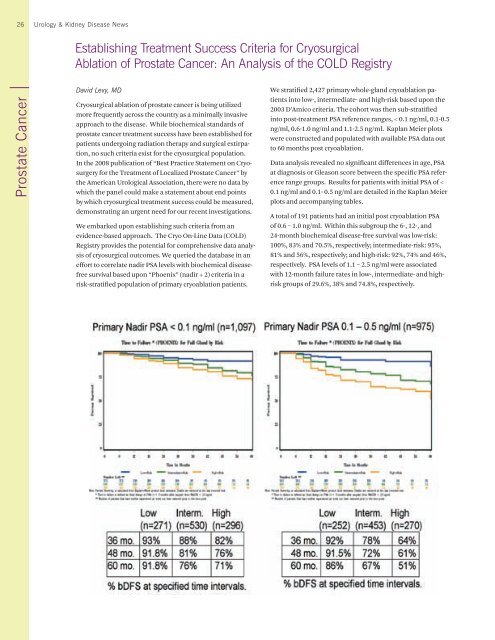Urology & Kidney Disease News Fall 2009 - Cleveland Clinic
Urology & Kidney Disease News Fall 2009 - Cleveland Clinic
Urology & Kidney Disease News Fall 2009 - Cleveland Clinic
You also want an ePaper? Increase the reach of your titles
YUMPU automatically turns print PDFs into web optimized ePapers that Google loves.
26 <strong>Urology</strong> & <strong>Kidney</strong> <strong>Disease</strong> <strong>News</strong><br />
Prostate Cancer<br />
Establishing Treatment Success Criteria for Cryosurgical<br />
Ablation of Prostate Cancer: An Analysis of the COLD Registry<br />
David Levy, MD<br />
Cryosurgical ablation of prostate cancer is being utilized<br />
more frequently across the country as a minimally invasive<br />
approach to the disease. While biochemical standards of<br />
prostate cancer treatment success have been established for<br />
patients undergoing radiation therapy and surgical extirpation,<br />
no such criteria exist for the cryosurgical population.<br />
In the 2008 publication of “Best Practice Statement on Cryosurgery<br />
for the Treatment of Localized Prostate Cancer” by<br />
the American Urological Association, there were no data by<br />
which the panel could make a statement about end points<br />
by which cryosurgical treatment success could be measured,<br />
demonstrating an urgent need for our recent investigations.<br />
We embarked upon establishing such criteria from an<br />
evidence-based approach. The Cryo On-Line Data (COLD)<br />
Registry provides the potential for comprehensive data analysis<br />
of cryosurgical outcomes. We queried the database in an<br />
effort to correlate nadir PSA levels with biochemical diseasefree<br />
survival based upon “Phoenix” (nadir + 2) criteria in a<br />
risk-stratified population of primary cryoablation patients.<br />
We stratified 2,427 primary whole-gland cryoablation patients<br />
into low-, intermediate- and high-risk based upon the<br />
2003 D’Amico criteria. The cohort was then sub-stratified<br />
into post-treatment PSA reference ranges, < 0.1 ng/ml, 0.1-0.5<br />
ng/ml, 0.6-1.0 ng/ml and 1.1-2.5 ng/ml. Kaplan Meier plots<br />
were constructed and populated with available PSA data out<br />
to 60 months post cryoablation.<br />
Data analysis revealed no significant differences in age, PSA<br />
at diagnosis or Gleason score between the specific PSA reference<br />
range groups. Results for patients with initial PSA of <<br />
0.1 ng/ml and 0.1- 0.5 ng/ml are detailed in the Kaplan Meier<br />
plots and accompanying tables.<br />
A total of 191 patients had an initial post cryoablation PSA<br />
of 0.6 – 1.0 ng/ml. Within this subgroup the 6-, 12-, and<br />
24-month biochemical disease-free survival was low-risk:<br />
100%, 83% and 70.5%, respectively; intermediate-risk: 95%,<br />
81% and 56%, respectively; and high-risk: 92%, 74% and 46%,<br />
respectively. PSA levels of 1.1 – 2.5 ng/ml were associated<br />
with 12-month failure rates in low-, intermediate- and highrisk<br />
groups of 29.6%, 38% and 74.8%, respectively.
















